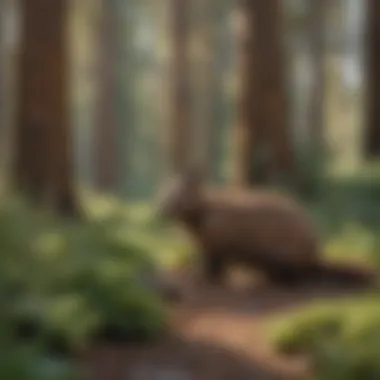Discover the Wonders of Sequoia National Forest Tours


Intro
Sequoia National Forest presents a unique and intricate tapestry of life, embodying a fascinating ecosystem that thrives in the Sierra Nevada mountains of California. Its towering giant sequoias, some of the largest and oldest trees on Earth, are not merely breathtaking sights; they symbolize the extraordinary biodiversity supported by the forest. As one delves into the various tours offered in this marvelous region, understanding its woodland ecosystems becomes essential. This knowledge enhances the experience of visitors, helping them appreciate the complexities inherent in nature.
In this exploration of Sequoia National Forest tours, we will investigate the fundamental aspects of its ecology. The article will cover the significance of biodiversity in forests, the role of these ecosystems in climate regulation, and best sustainable practices to consider while engaging with this remarkable environment.
Moreover, we will address the various tour options available, including educational programs, guided adventures, and self-directed explorations. Each of these experiences not only highlights the natural beauty but also integrates the educational dimension, emphasizing the necessity of responsible interaction with this unique landscape.
Through this comprehensive guide, readers will learn about key practices that promote sustainability in forestry. Exploring the intersection of education and conservation, we aim to provide valuable insights for a range of audiences, from forestry professionals to environment advocates. Thus, this analysis is not simply about enjoying nature; it fosters a deeper understanding of one's role in preserving these vital ecosystems.
Preface to Sequoia National Forest
The Sequoia National Forest is not just a collection of ancient trees; it is a profound example of ecological history and biodiversity. In this section, we will explore its geographical characteristics and the ecological significance of the giant sequoias.
Geographical Overview
Sequoia National Forest sprawls over 404,000 acres in the southern Sierra Nevada mountains of California. It sits just east of Fresno and is part of the larger Sequoia and Kings Canyon National Parks, both of which share boundaries. The terrain features a variety of ecosystems, from the low foothills to the towering granite peaks of the Sierra Nevada. Here, diverse topographical features create microclimates that support rich biodiversity.
The forest is home to memorable landmarks, such as Mount Whitney, the highest peak in the contiguous United States, and the striking sequoia trees themselves, which are considered among the oldest living organisms on earth. These trees can grow to be more than 300 feet tall and can live for over 3,000 years. The geographical diversity within the forest plays a critical role in supporting its unique flora and fauna, providing a dramatic backdrop for tours and exploration.
Ecological Importance of Sequoias
The ecological significance of the giant sequoias cannot be overstated. These trees have adapted to the unique conditions of this mountainous area, thriving in clay soil and high elevations. Their thick bark provides insulation against fires, a natural occurrence in the forest. This characteristic is vital for their survival, as fire plays a fundamental role in maintaining the health of their ecosystem.
Giant sequoias create habitats not only for various plant species but also for numerous wildlife, including black bears, deer, and many birds. Their towering presence supports a complex web of life, demonstrating the interconnectedness of species that rely on sequoias for shelter and sustenance.
Furthermore, these majestic trees are vital for carbon sequestration, aiding in climate regulation. They absorb significant amounts of carbon dioxide, thus playing an essential role in combating climate change. Understanding the importance of the Sequoia National Forest is crucial for conservation efforts and promotes a sustainable approach to tourism.
"Conservation of Sequoias is not merely about protecting trees; it involves safeguarding intricate ecosystems that depend on them."
This introductory exploration of the Sequoia National Forest sets the stage for a deeper analysis of the various tours available and the unique experiences they offer.
Types of Tours Available
The diverse tours offered in Sequoia National Forest serve multiple purposes, catering not only to recreational enjoyment but also to educational and ecological values. Understanding the Types of Tours Available is crucial for maximizing the benefits one can draw from this majestic area. Each type of tour provides a unique lens through which to view the forest's vast ecosystems, awe-inspiring landscapes, and storied history. Tours can offer insights into the ecology, geology, and conservation efforts, enriching one’s experience of this natural wonder.
Guided Nature Hikes
Guided nature hikes are a premier option for those who wish to immerse themselves in the grandeur of Sequoia National Forest while benefiting from the expertise of knowledgeable guides. These hikes often cover various trails that showcase the park's unique flora and fauna. Participants can expect detailed explanations about the towering sequoias, a species that plays a critical role in the forest's ecological balance.
The value of these guided hikes lies not only in the physical activity but also in the enhanced understanding of the environment. Hikers can experience the forest in a more meaningful way, as guides often share historical anecdotes and scientific facts that deepen the hike’s significance. Additionally, these tours are typically structured to accommodate various fitness levels, making them accessible to a broader audience.


Educational Workshops
Educational workshops provide an opportunity for individuals or groups interested in more hands-on learning experiences. These workshops may focus on a range of topics, including botany, ecology, and conservation practices. Participants engage in interactive sessions that sometimes involve field studies, allowing them to observe ecosystems closely.
The workshops are suitable for professionals, students, and the general public. They emphasize not only understanding the forest's complexities but also fostering a sense of stewardship among participants. Knowledge gained from these workshops can inspire actions that contribute to conservation efforts long after the participants leave the forest.
Wildlife Observation Tours
For those fascinated by wildlife, observation tours offer the chance to observe various species in their natural habitats. These tours are often led by enthusiastic guides who are well-versed in the behavior and characteristics of local animals. Common sights include deer, black bears, and an assortment of bird species unique to the region.
These tours can be a powerful experience as they highlight the importance of habitat preservation. Observing wildlife in their natural settings stresses the need for ongoing conservation efforts and the impact of human interaction with these majestic creatures. It’s an educational experience that reinforces the interconnectedness of life within the ecosystem.
Photography Expeditions
Photography expeditions cater to those who seek to capture the beauty of Sequoia National Forest through their lenses. These tours are typically guided by experienced photographers who offer tips on composition, lighting, and technique suitable for landscape and wildlife photography. Participants have the chance to explore stunning vistas, from ancient sequoias to rugged mountain landscapes.
The expedition provides both guidance and the freedom to focus on personal photography goals. Photographers can expect to receive constructive feedback on their shots, learning not only to take pictures but also to appreciate the finer details of nature. Such tours often conclude with discussions on post-processing techniques, making them comprehensive experiences for photography enthusiasts.
"Experiencing Sequoia National Forest through guided tours allows for profound understanding and appreciation of its natural beauty and ecological significance."
Planning Your Visit
Planning a visit to Sequoia National Forest requires careful consideration. This majestic area offers a range of experiences, and knowing how to navigate them can enhance your trip significantly. The significance of planning cannot be overstated, as it influences not only your enjoyment but also your interaction with the environment. Visitors can avoid the stress that often accompanies unprepared trips, allowing for a more immersive experience. Additionally, understanding the logistics can significantly affect how you connect with the natural beauty surrounding you.
Best Times to Visit
Sequoia National Forest is a year-round destination, but each season presents unique features. Spring marks the stunning bloom of wildflowers and a thawing landscape. This is an excellent time for nature hikes since temperatures are mild. Summer attracts many tourists, as it is the peak season for most tours. Expect busy trails but also fully operational facilities and services. The fall offers a spectacular display of autumn colors, making it a favorite for photographers. Finally, winter transforms the forest into a stunning white landscape, perfect for snowshoeing and solitude but requires preparation for cold weather.
Necessary Permits and Reservations
Before venturing into Sequoia National Forest, understanding permit requirements is essential. Most tours do not require advanced reservations, especially for general entry. However, certain activities like overnight camping and specialized tours may require permits. It is wise to check the latest regulations on the official National Park Service website. Many beautiful spots operate on a reservation system to manage crowding during peak times, ensuring a more enjoyable experience.
Packing Guidelines
Effective packing is crucial. Start with appropriate clothing; layering is beneficial due to fluctuating temperatures. A sturdy pair of hiking boots will add comfort and support during treks. In addition to clothing, don't forget essentials like:
- A water bottle to stay hydrated.
- Snacks to keep your energy levels up.
- A first aid kit for minor injuries.
- Sunscreen and insect repellent to protect against the elements.
- Trail maps or GPS devices to navigate the area confidently.
Prepare for your visit by gathering these items. The more prepared you are, the more you can focus on enjoying the stunning scenery that Sequoia National Forest provides.
The Experience of a Tour


Understanding the experience of a tour in Sequoia National Forest is crucial for appreciating what this majestic area has to offer. The tours are not just avenues for recreation; they connect visitors to the rich ecological and cultural tapestry of the forest. Through these guided experiences, participants have the chance to not only see significant natural features but also to engage meaningfully with the environment. This engagement fosters a deeper respect for nature and encourages responsible interaction with it.
What to Expect on a Guided Tour
When you join a guided tour in Sequoia National Forest, several expectations shape the overall experience. First, you will typically be welcomed by knowledgeable guides who possess a deep understanding of the area’s history, ecology, and conservation efforts. This foundational knowledge enriches your experience.
Guided tours usually start with a brief introduction, outlining safety protocols and itinerary. Participants are then led through various trails where tours might highlight important features such as giant sequoias. Expect to walk at a moderate pace that accommodates varying fitness levels.
Additionally, you may encounter information stations along the way. These provide insights into local wildlife, plant species, and geological formations. Being part of a guided tour ensures you gain context for the flora and fauna you encounter, transforming the journey from a mere hike into an educational experience.
Interaction with Nature
The interaction with nature during these tours is a centerpiece of the experience. Visitors often find themselves surrounded by towering sequoias, some of the oldest and largest trees in the world. These encounters can be profoundly impactful, creating a sense of awe and appreciation for nature.
While on the tours, participants can engage directly with the environment through various activities. These may include listening to bird calls, observing wildlife, and even touching the bark of ancient sequoias. Such experiences enhance one's sensory connection with the forest. However, it is important to remember that maintaining a respectful distance from wildlife is essential to promote their well-being.
Guided tours often incorporate mindfulness practices, allowing participants to pause and reflect while taking in their surroundings. Such moments can deepen the relationship with the natural world, fostering a sense of stewardship toward conservation efforts.
Learning Opportunities
Tours in Sequoia National Forest also serve as rich learning opportunities. Participants can expand their understanding of ecology and environmental science. Educational discussions on biodiversity, ecosystem dynamics, and conservation challenges are commonplace.
Guides may share stories that date back centuries, linking historical and contemporary issues regarding land use and indigenous practices. Engaging with these narratives provides a fuller picture of the region’s significance, encouraging visitors to reflect on their role in preserving such spaces.
In addition, many tours offer hands-on activities. This could be anything from participating in citizen science projects to studying tree ring patterns that unveil historical climate data. Such involvements not only enhance engagement but also promote a greater sense of responsibility towards future ecological conservation.
"Experiencing Sequoia National Forest through guided tours fosters connection to the land and encourages sustainable practices among visitors."
Ecological Impact of Tours
Understanding the ecological impact of tours in Sequoia National Forest is essential for ensuring sustainable practices. Tours provide opportunities for people to connect with nature, but they can also lead to potential disturbances in delicate ecosystems. The balance between visitor enjoyment and environmental preservation is crucial. Consequently, we will examine sustainable tourism practices as well as conservation efforts in this section.
Sustainable Tourism Practices
Sustainable tourism practices in Sequoia National Forest aim to minimize negative impacts while maximizing educational and conservation opportunities. Visitors can engage in various activities that promote responsible enjoyment of the park. Key strategies include:
- Guided tours with certified professionals: Experts can help educate visitors about the ecosystem, ensuring that they understand the importance of preserving the area.
- Leave No Trace principles: Tour participants are encouraged to follow these principles, which include staying on designated trails, not disturbing wildlife, and carrying out all trash.
- Group size limitations: Smaller groups reduce the physical impact on the environment and allow for a more personalized experience. This practice minimizes damage to flora and fauna.
- Support for local communities: Choosing tours that benefit local economies reinforces the importance of conservation, as revenue generated through tourism can fund preservation efforts.
By adopting these practices, tourists can enjoy the beauty of Sequoia National Forest while contributing to its protection.
Conservation and Preservation Efforts


Conservation and preservation efforts related to Sequoia National Forest are vital for maintaining the forest's ecological integrity. These initiatives often include a combination of community involvement and scientific research. Notable efforts include:
- Restoration projects: Initiatives aimed at restoring damaged ecosystems, particularly areas impacted by heavy foot traffic or invasive species, are imperative. These projects often involve collaboration between park rangers, local volunteers, and ecologists.
- Monitoring programs: Regular monitoring of flora and fauna helps to identify any changes or threats to the ecosystem. This information can guide management strategies and the development of new policies.
- Education and outreach: Informing the public about the significance of conservation encourages responsible behavior among visitors. Educational workshops and materials can highlight the necessity of protecting the forest.
Protecting Sequoia National Forest requires a concerted effort from both visitors and conservationists. By understanding their role in maintaining this natural habitat, individuals can make informed decisions during their tours.
Ultimately, a commitment to sustainable practices and preservation can ensure that future generations experience the wonders of Sequoia National Forest. The interplay between tourism and ecology is delicate, but with concerted efforts, this majestic landscape can remain a hub of biodiversity and natural beauty.
Cultural Significance of Sequoias
The cultural significance of sequoias extends beyond their impressive stature and ecological roles. These majestic trees symbolize resilience, continuity, and the complex interrelation between nature and human experiences. Understanding this significance is essential for appreciating the myriad benefits these trees offer, along with the responsibilities that come with visiting their habitat.
Historical Context
The historical context of sequoias reveals a narrative rich with human interaction and reverence for nature. For centuries, sequoias have stood as remarkable landmarks, often serving as points of reference and inspiration. They have witnessed transformations over time, including changes in land use, conservation efforts, and the rise of tourism. The arrival of settlers in California during the 19th century marked a pivotal moment in how sequoias were regarded. Initially seen as a resource for logging, a turning point occurred when people began to recognize their beauty and ecological value. Landmark events, such as the establishment of the Sequoia National Park in 1890, helped protect these trees and popularize their historical legacy.
Several notable historical events intertwine with the fate of sequoias:
- Logging Practices: In the late 1800s, extensive logging reduced sequoia populations dramatically. This unsustainable practice highlighted the need for conservation.
- National Parks Movement: The movement to create national parks, driven by environmentalist sentiment, secured protections for these ancient giants.
- Cultural Symbolism: Sequoias became symbols of natural grandeur, inspiring artists, writers, and environmental activists alike.
Sequoias in Indigenous Cultures
Sequoias hold profound significance in many Indigenous cultures of California, where they are interwoven into spiritual beliefs and practices. Native American tribes, such as the Tule River Indian Tribe and the Mono Tribe, regard these trees with immense respect. They view sequoias not only as vital resources but as sacred beings deserving of stewardship and protection.
Indigenous cultures have long utilized sequoias in various ways:
- Materials for Shelter: The trees provided timber for building traditional structures, showcasing a deep understanding of sustainable use.
- Traditional Practices: Many tribes incorporated sequoias into rituals, celebrating the connection between nature and spirituality.
- Cultural Heritage: Stories and legends about sequoias contribute to the cultural preservation of Indigenous identities.
It is evident that the sequoias are more than mere trees; they embody history, culture, and collective wisdom of the Indigenous peoples. Acknowledging this aspect is crucial for responsible tourism and fostering greater appreciation of their cultural legacy.
"To the Indigenous peoples, sequoias are not just trees, but living entities, part of spiritual beliefs and a reminder of harmony with nature."
The End and Future Considerations
In summing up the discussions surrounding tours in Sequoia National Forest, it is essential to recognize the interplay between community engagement and sustainable tourism. This connection is not merely beneficial; it is vital for the future of both the forest and the tours driven by its natural heritage. Visitors and locals alike have a role in safeguarding the ecological balance and fostering a deeper understanding of the forest’s unique ecosystems.
The Role of Community in Conservation
Community involvement in conservation efforts significantly shapes the future of Sequoia National Forest. Local stakeholders can influence the management practices and policies that impact the forest. By fostering a culture of stewardship, communities can also contribute to the richness of visitor experiences. Volunteer programs can bring individuals together, allowing them to engage in hands-on conservation work. This creates not only a sense of responsibility but also a deeper connection between people and their environment.
Moreover, community-led initiatives can educate visitors about the ecological importance of sequoias. When locals share their knowledge and experiences, tourists experience the forest differently. It helps them understand not just what they see but the narrative behind these towering trees. This narrative can catalyze a profound respect for the forest and its delicate ecosystems.
Encouraging Sustainable Practices
Promoting sustainable practices is critical for the resilience of Sequoia National Forest. This involves both individual actions and collective efforts. Tour companies can lead the way by implementing eco-friendly policies like waste reduction and resource conservation. Simple measures, such as using recycled materials and minimizing vehicle emissions, can significantly reduce the environmental footprint.
Visitors also have a part to play. They can practice responsible tourism by adhering to regulations and guidelines set by park officials. Such practices include staying on marked trails, respecting wildlife, and leaving no trace behind. By fostering an environment of accountability, tourists help ensure the forest remains unspoiled for future generations.







